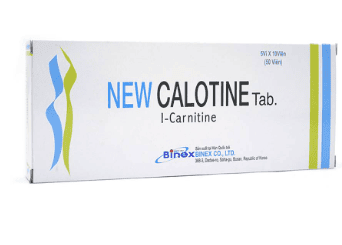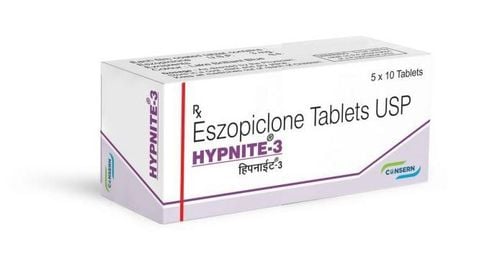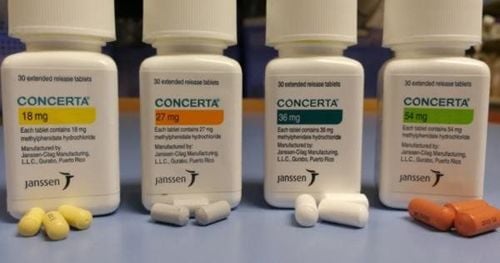This is an automatically translated article.
Zopiclone has sedative and anxiolytic effects similar to benzodiazepines. This active ingredient is in Zopistad 7.5. So what is Zopistad and in what cases is it indicated?1. What is Zopistad?
Zopiclone belongs to the cyclopyrrolon group with properties similar to benzodiazepine derivatives, including sedative, anxiolytic, muscle relaxant, amnesia, and anticonvulsant. Zopistad 7.5 has an indirect effect on increasing the activity of gamma - aminobutyric acid (GABA) in the brain, and the active ingredient Zopiclone binds to the benzodiazepine receptor of the GABA receptor complex but at a different position compared to benzodiazepine derivatives. .Zopistad 7.5 has a short duration of action, rapid onset of sleep but no reduction in total time of rapid eye movement (REM) sleep and maintenance of normal slow wave sleep. In general, Zopistad 7.5 is effective as a hypnotic similar to benzodiazepine derivatives.
2. Indications and contraindications of Zopistad 7.5
Zopistad 7.5 is indicated in the following cases:
Short-term treatment of insomnia, including difficulty falling asleep, or waking up at night and waking up early, transient, temporary or chronic insomnia; Insomnia secondary to a mental disorder; Treatment of cases of insomnia that leave the patient severely debilitated or exhausted. Zopistad 7.5 is contraindicated for use in the following cases:
Patients who are allergic to Zopiclone or any of the excipients contained in Zopistad 7.5; Patients with severe myasthenia gravis, respiratory failure, severe sleep apnea syndrome, severe liver failure; Do not give Zopistad 7.5 to children.
3. Dosage, how to use Zopistad 7.5
3.1. Dosage Zopistad 7.5 should be used at the lowest effective dose for each course of treatment; Patients should take Zopistad 7.5 at bedtime in a standing position. 3.2. Dosage of Zopistad 7.5
Adults: The usual dose is 1 Zopistad 7.5 tablet; Elderly: It is recommended to start with a dose of 3.75mg (1⁄2 tablets of Zopistad 7.5); Patients with mild to moderate renal or hepatic impairment: Zopiclone should be initiated at a dose of 3.75mg (1⁄2 Zopistad 7.5 tablets); The duration of treatment for temporary insomnia with Zopistad 7.5 is 2 - 5 days, short-term insomnia is 2 - 3 weeks. Note that a course of treatment with Zopistad 7.5 should not last more than 4 weeks (including dose reduction). 3.3. Overdosage of Zopistad 7.5 and treatment Zopistad overdose symptoms include drowsiness, coma, ataxia... Besides, some deaths have also been recorded after taking an overdose of Zopiclone; Treatment of overdose Zopistad 7.5 is mainly supportive. Adults who take more than 150mg of Zopiclone or children who take 1.5mg/kg within 1 hour can prescribe activated charcoal. In addition, gastric lavage is also considered for overdose within 1 hour if there is a life-threatening risk; Flumazenil is indicated in cases of Zopistad overdose and severe CNS depression. Consciousness is rapidly restored following intravenous administration of the active ingredient Flumazenil to a patient with an overdose of Zopiclone.
4. Side effects of Zopistad 7.5
Common side effects of Zopistad 7.5: Bitter mouth or metallic taste..
Uncommon side effects of Zopistad 7.5: Mild gastrointestinal upset, including nausea/vomiting, dizziness, headache; doze; Dry mouth.
Rarely, the following side effects of Zopistad 7.5: irritability, aggression, confusion, amnesia, lightheadedness, sleepwalking, hallucinations, nightmares; anaphylactic reaction;
Zopistad 7.5 withdrawal symptoms changed including insomnia return, anxiety, tremor, sweating, agitation, confusion, headache, palpitations, tachycardia, delirium, nightmares, hallucinations, panic attacks, muscle aches/cramps, gastrointestinal disturbances and irritability. In addition, epileptic seizures can also occur, but are very rare.
5. Be careful when using Zopistad 7.5
Risk of drug dependence: Clinical experience to date with Zopiclone shows that the risk of dependence is very small when the duration of therapy does not exceed 4 weeks. The risk of dependence on Zopistad 7.5 increases with dose and duration of therapy, the risk is higher in patients with a history of alcohol and/or drug abuse, and personality disorders. If physical dependence develops, abrupt discontinuation of treatment with Zopistad 7.5 will be accompanied by withdrawal symptoms. Withdrawal symptoms: Discontinuation of treatment with Zopistad 7.5 is unlikely to be associated with withdrawal symptoms when treatment is limited to 4 weeks. Patients may benefit from a gradual dose reduction before stopping completely. Depression: Zopistad 7.5 is not indicated for the treatment of depression. Any cause of insomnia should be identified prior to treatment to avoid potentially serious symptoms of depression. Tolerance: There were no signs of tolerance to Zopiclone with treatment duration of less than 4 weeks. Relapse Insomnia: Because the risk of withdrawal or return of insomnia may increase with prolonged treatment, or with abrupt discontinuation, a stepwise reduction in the dose of Zopistad 7.5 may be helpful. Amnesia: Although rare, later amnesia may occur in patients receiving Zopistad 7.5, particularly when sleep is disrupted or delayed following use of the drug. Therefore, patients should only take Zopistad 7.5 when it is certain that they will go to bed and can get a full night's sleep. Zopistad 7.5 contains lactose, therefore patients with rare hereditary problems of galactose intolerance, total lactase deficiency or glucose-galactose malabsorption should not take this product. Ability to drive and use machines: Although adverse reactions are rare and usually of negligible influence, patients should not drive or operate machines after treatment with Zopistad 7.5 until determined. the performance of these works is not affected. Experience with the use of Zopistad 7.5 during pregnancy is limited, although there have been no adverse findings in animals. Therefore, Zopistad 7.5 should not be used during pregnancy. The use of Zopistad 7.5 should be avoided in nursing patients because Zopiclone is excreted in human milk.
6. Zopistad drug interactions 7.5
Zopistad 7.5 should not be used concurrently with alcohol because alcohol increases the sedative effect of Zopiclone, especially the high risk of affecting the ability to drive or use machines. CNS depressants in combination with Zopistad 7.5 may potentiate the neuroleptic effect, therefore the therapeutic benefit should be carefully considered when combining Zopistad 7.5 with antipsychotic agents (neuronal tranquilizers). ), sleeping pills, anxiolytics/sedatives, antidepressants, narcotic analgesics, anesthetics, antihistamines with sedative side effects, antiepileptics, Concomitant use of Benzodiazepines or Benzodiazepine-like drugs with narcotic analgesics can increase feelings of euphoria, which in turn lead to increased mental dependence. Drugs that inhibit certain liver enzymes (especially cytochrome P450) may potentiate the effects of benzodiazepines and benzodiazepine-like drugs such as Zopistad 7.5. CYP3A4 Inhibitors (Erythromycin, Clarithromycin, Ketoconazole, Itraconazole and Ritonavir): Because Zopiclone is metabolised by cytochrome P450 CYP3A4, plasma concentrations of Zopistad 7.5 may be increased when Zopistad 7.5 is co-administered with CYP3A4 inhibitors. It is recommended that the dose of Zopistad 7.5 be reduced when co-administered with CYP3A4 inhibitors. CYP3A4 Inducers (Rifampicin, Carbamazepine, Phenobarbital, Phenytoin): Zopiclone plasma concentrations are decreased when co-administered with CYP3A4 inducers. Therefore, the dose of Zopistad 7.5 should be increased when co-administered with inducers of CYP3A4.
Please dial HOTLINE for more information or register for an appointment HERE. Download MyVinmec app to make appointments faster and to manage your bookings easily.













